第 10 类 RD Sharma 解决方案 - 第 5 章三角比 - 练习 5.1 |设置 3
问题 22. 如果 sinθ = a/b,根据 a 和 b 求 secθ + tanθ。
解决方案:
Given:
sinθ = a/b
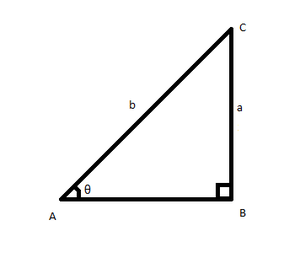
From Pythagoras theorem,
AC2 = BC2 + AB2
b2 = a2 + AB2
AB2=![]()
Now,
= secθ + tanθ
=![]()
=![]()
=
=
=![]()
问题 23. 如果 8tanA = 15,求 sin A - cos A。
解决方案:
Given:
8tanA = 15
tanA = 15/8
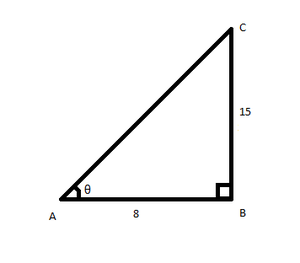
From pythagoras theorem,
AC2 = BC2 + AB2
AC2 = 152 + 82
AC2 = 225 + 64 = 289
AC = 17
Now,
= sin A − cos A
= 15/17 – 8/17
= (15 – 8)/17
= 7/17
问题 24. 如果 tanθ = 20/21,证明 .
.
解决方案:
Given: tanθ = 20/21

From Pythagoras theorem,
AC2 = BC2 + AB2
AC2 = 202 + 212
AC2 = 400 + 441 = 841
AC = 29
Now, taking LHS
=![]()
=
=![]()
= 30/70
= 3/7
问题 25. 如果 cosec A = 2,求 .
.
解决方案:
Given:
cosec A = 2
We know
sin A = 1/cosecA = 1/2
And, sin 30° = 1/2
A = 30°
tan30° = 1/√3 and cos30° = √3/2
Now,
=![]()
=
=
=![]()
=![]()
=![]()
= 2
问题 26. 如果∠A和∠B是锐角,使得cos A = cos B,则证明∠A = ∠B。
解决方案:
Let us consider a △ABC
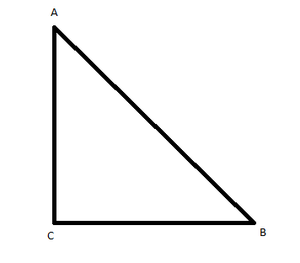
From the figure,
Given,
cos A = cos B
AC/AB = BC/AB
Multiplying both side by AB
(AC/AB) × AB = (BC/AB) × AB
AC = BC
In △ABC, AC = BC So we can say that the triangle is an isosceles triangle,
and in an isosceles triangle we know that if two sides of a triangle are equal,
then the angle opposite to the sides are equal.
Therefore, ∠A =∠B
问题 27. 在与 A 成直角的 Δ ABC 中,如果 tanC = √3,求 sin B cos C + cos B sin C 的值。
解决方案:
In right angled Δ ABC,
Given: tan C = √3
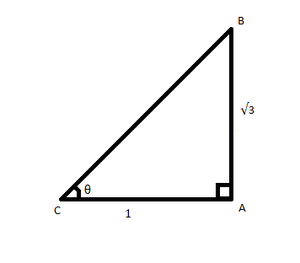
∴AB = √3 and AC = 1
From pythagoras theorem,
BC2 = AB2 + AC2
BC2 = (√3)2 + 12
BC2 = 3 + 1 = 4
BC = 2
Therefore,
sin B cos C + cos B sin C
= (1/2)(√3/2) + (√3/2)(√3/2)
= 1/4 + 3/4
= 4/4
= 1
问题 28. 说明以下是对还是错。证明你的答案。
(i) tan A 的值始终小于 1。
解决方案:
FALSE. The value of tan A is not always less than 1.
Consider the Pythagorean triplet, 13, 12, and 5
where, 13 is the hypotenuse
We know
tan A = Perpendicular/Base
Let Perpendicular = 12 and Base = 5
then, tanA = 12/5 = 2.4 which is greater than 1.
(ii) 对于角度 A 的某个值,sec A = 12/5。
解决方案:
TRUE
We have sec A = 12/5 for some value of ∠A
secθ = Hypotenuse/Base
In a right angled triangle, hypotenuse is the greatest side.
So secθ > 1 is valid
Here, secθ = 12/5
(iii) cos A 是角 A 的余割线的缩写。
解决方案:
FALSE
cos A means cosine of ∠A
cos A = Base/Hypotenuse
However,
cosec A = Hypotenuse/Perpendicular
(iv) cot A 是 cot 和 A 的乘积。
解决方案:
FALSE
cot A means Cotangent of ∠A
cot A = 1/tanA
Only “cot” doesn’t defines anything.
Hence, cot A is not the product of cot and A.
(v) 对于某个角度 θ,sinθ = 4/3。
解决方案:
FALSE
sinθ = 4/3 for some value of ∠θ
We have,
sinθ = Perpendicular/Hypotenuse
In a right angled triangle, hypotenuse is the greatest side.
So sinθ is always less than 1.
Here, sinθ = 4/3 = 1.3 which is greater than 1
问题 29. 如果 sinθ = 12/13,求 .
.
解决方案:
Given:
sinθ = 12/13
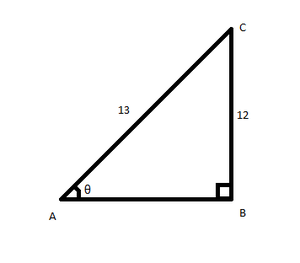
Using Pythagoras theorem,
AC2 = BC2 + AB2
132 = 122 + AB2
AB2 = 169 − 144 = 25
AB = 5
= ![]()
=
=
=
=![]()
= 595/3456
问题 30. 如果 cosθ = 5/13,求 .
.
解决方案:
Given:
cosθ = 5/13
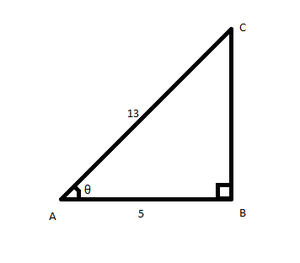
Using Pythagoras theorem,
AC2 = BC2 + AB2
132 = BC2 + 52
BC2 = 169 − 25 = 144
BC = 12
= ![]()
=
= 
=
= ![]()
= 595/3456
问题 31. 如果 secA = 5/4,验证 .
.
解决方案:
Given:
secA = 5/4
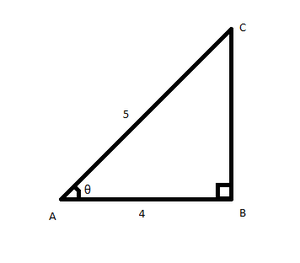
From pythagoras theorem,
AC2 = BC2 + AB2
52 = BC2 + 42
BC2 = 25 − 16 = 9
BC = 3
Now
=![]()
=
=
=
=
= 117/-44 = 117/(11(4))
= 117/-44 = 117/-44
Hence Proved
问题 32. 如果 sinθ = 3/4,证明 .
.
解决方案:
Given: sinθ = 3/4
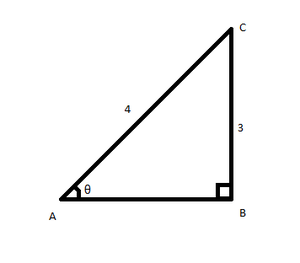
From Pythagoras theorem,
AC2 = BC2 + AB2
42 = AB2 + 32
AB2 = 16 – 9 = 7
AB =√7
We have,
![]()
Now squaring both side
=![]()
=![]()
= 7/9
We know
1 + cot2θ = cosec2θ
1 + tan2θ = sec2θ
= 1/tan2θ = 7/9
=![]()
= 7/9 = 7/9
Hence Proved
问题 33. 如果 secA = 17/8,验证 .
.
解决方案:
Given: secA = 17/8

From Pythagoras theorem,
AC2 = BC2 + AB2
172 = BC2 + 82
BC2 = 289 − 64 = 225
BC = 15
We have
![]()
Putting the values of sinA, cosA and tanA in the above equation
=
=
=
=
= 33/611 = 33/611
Hence Proved
问题 34. 如果 cotθ = 3/4,证明 .
.
解决方案:
Given: cotθ = 3/4
tanθ = 4/3
Using the pythagoras theorem
sinθ = 4/5, cosθ = 3/5
cosecθ = 5/4, secθ = 5/3
Now, taking LHS
=![]()
=
=
=![]()
= 1/√7
问题 35. 如果 3cosθ - 4sinθ = 2cosθ + sinθ,则求 tanθ。
解决方案:
Given: 3cosθ − 4sinθ = 2cosθ + sinθ
Dividing both equation by cosθ we get,
![]()
3 – 4tanθ = 2 + tanθ
3 – 2 = 4tanθ + tanθ
tanθ = 1/5
问题 36. 如果∠A和∠B是锐角,使得tan A = tan B,则证明∠A = ∠B。
解决方案:
Let us consider a △ABC
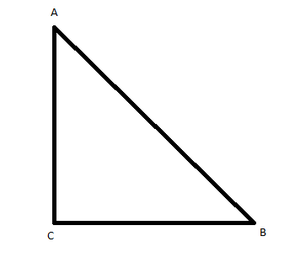
From the figure,
Given:
tan A = tan B
BC/AC = AC/BC
AC2 = BC2
AC = BC
In △ABC, AC = BC So we can say that the triangle is an isosceles triangle, √3
and in an isosceles triangle we know that if two sides of a triangle are equal,
then the angle opposite to the sides are equal.
Therefore ∠A =∠B